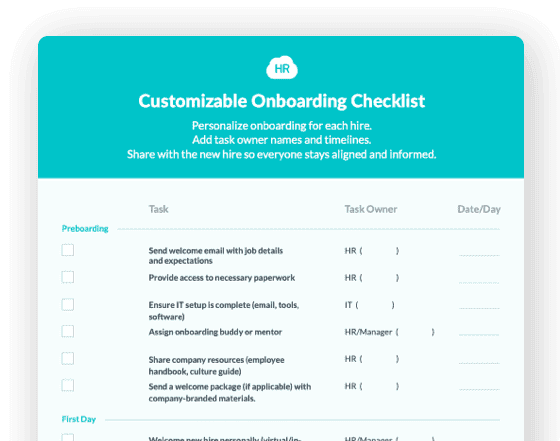4 Steps to Creating a Collaborative Culture and Staff That Thinks Like One



 Cut onboarding time
by 60%—here's the
Ultimate Checklist
that helped do it.
Cut onboarding time
by 60%—here's the
Ultimate Checklist
that helped do it.

Humans are made to live and work in groups. It is an undeniable fact. Humans have always strived to create strong social structures for their benefit and protection. Humanity has evolved from tribes to today’s multicultural megacities. This great change has been possible through mutual collaboration.
Similarly, there have been immeasurable changes in building effective teams in the workplace. This has not happened by chance but as a result of endless efforts and teamwork.
Now the definition and nature of teams are changing. New layers of complexity are being added to foster strong collaboration. In the digitalized era, teams no longer sit in the same corner of the office. The emergence of cloud technology and collaboration tools ensures that work can be done from anywhere and at any time. Work is no longer limited to space and time concepts.
The importance of promoting teamwork and encouraging cross-collaboration is on the rise across all industries. Recognizing individual accomplishments has always been an important part of motivating the workforce. However, bringing people together to accomplish a common goal in an environment of trust has become critical for the company’s growth.
There has been a drastic change in the work collaboration platform over the years. The dramatic enhancements in technology have changed the way how people collaborate at workplaces now.
Change is inevitable. Organizations that do not adapt to the fast-changing business demands are at risk of stagnation. At times, businesses feel uncomfortable to stepping out and doing things differently. However, change is unfolding at a faster rate than ever before.
Make collaboration a priority
Collaboration is critical to a team's success. In today’s world, organizations need more than new technology to develop a collaborative business culture. In a competitive environment, only high-performing teams can thrive. By providing tools for company collaboration, it can improve communication and make companies feel more transparent. However, where the workplace culture is fundamentally broken no platform or tool can work.
Before finding solutions, it’s important to consider whether company leaders prioritize teamwork. The organizations have to involve employees and communicate with them to embrace collaboration methods and techniques. Most often, poor leadership is a reason for failure to bring in new technologies and tools to implement a collaborative culture. Secondly, employees are also most likely to quit because of poor leadership and weak guidance.
Nothing can be simpler than just asking employees for their opinions. It could be the invitation they need to offer up their contributions. If organizations want employees to collaborate, they should start leading by example.
Collaboration improves the way how a team works together and problem-solves. Collaboration leads to innovation, increased success, and improved communication. The concept where a boss dictates what needs to be done has fallen aside. It has been replaced with responsible employees presenting solutions to a problem they have been assigned to solve.
The organizations that manage to build collaboration into their culture will thrive. Companies need to change their training methods to ensure that employees are comfortable in a more flexible and shared environment. Organizations have to prioritize the collaboration culture to sustain growth.
Creating a team culture in business
Every organization has its unique culture. It is an open secret that team culture is important for success. Teamwork is an essential component of a growing enterprise. Sometimes, some challenges arise while blending different personalities and talents.
Organizational teams are a combination of multiple personalities, skill sets, and micro-cultures. They all get together and operate towards common goals. This amalgamation of different backgrounds and subcultures forms a new culture. The company leaders influence the dynamics of the new culture. Leaders are responsible for giving a new direction to this established culture. Effective team collaboration at work is the result of the combined efforts of team managers.
What is a collaborative culture?
Collaboration represents how people within an organization communicate, relate, and work with one another. People with different backgrounds and talents work towards a common mission, goals, and objectives. To put it simply, collaboration is the heart of teamwork. It makes the team successful.
Developing a collaborative culture is essential to accomplish the company's goals. It helps to fulfill the mission of the organization. Collaboration is an integral part of every organization. However, not every company has a collaborative culture.
So what is the difference?
In a collaborative culture, collaboration is regular and deliberate. Collaboration is embedded into processes of how people do their work every day. It is in the attitudes that an employee takes to their work. Collaborative culture values and practices the idea that we are better together. It is based on the idea that collective intelligence brings in the most creative solutions.
What are the benefits of a collaborative culture?
In the quest for creative solutions, many organizations look for ways to become more collaborative.
“Innovation” is the buzzword these days. Every organization wants to create products, processes, and tools to stay alive in the globalized economy. For them failing to innovate can mean failing to survive. The shortest and most powerful route to innovate is collaboration. The studies have found that enterprises with collaborative cultures are five times more likely to be high-performing.
A collaborative culture ignites innovation. It is the magic formula in bringing out the best in employees. Collaborative culture makes the employee feel a part of a team effort. He gets more energized, productive, and adaptable. Collaboration develops feelings of involvement making the employee happier and less stressed.
Therefore collaborative employees are engaged and productive. Employees who are engaged are the ones who stick around. Collaborative culture promotes employee retention and helps in attracting and recruiting top talent. Learn a few ways to engage your team.
What hinders workplace collaboration?
If collaboration is so effective, why aren't all companies doing more of it?
Well, the reason is some people haven't developed the skills to establish a collaborative culture. They are not adequately trained and groomed to contribute to the collaborative culture. Sometimes, people with good collaboration skills hold back while at the workplace. This happens when the managers dictate and direct every move. The trust in the employee’s abilities is missing. Employees are not encouraged to collaborate.
Sometimes, an employee feels that collaboration is something that is to be emphasized occasionally. They feel that collaboration is not the skill they would be rewarded for. Therefore, managers have a great motivational role in developing and encouraging a collaborative culture.
Some companies have an entrenched culture of silos. It promotes competition amongst employees instead of encouraging a collaborative and sharing attitude. The culture tends people to hoard information and knowledge as a source of power.
Other companies fail to keep up with all the new ways. They do not recognize and accept that they can work and collaborate. They fail to enthuse the teams and build the trust that they need to collaborate effectively. Sometimes, employees lack the communication tools they need to collaborate with colleagues based at multiple locations.
A positive collaboration attitude magnifies employee’s strengths and capabilities. It invariably helps in employee retention. Still more, positive collaboration brings employees together, enhances communication, and builds strong relationships at the workplace. All these factors act as catalysts that improve productivity.
Here are 4 steps to creating a collaborative culture that makes the staff think like one.
1. Create an environment of trust and transparency
Trust is the foundation of any relationship or association. A team without trust isn't a team. When the trust factor is missing amongst the team members it becomes just a group of working individuals. These groups often make disappointing progress. In the absence of trust, people avoid sharing information and may not cooperate. The talent and capabilities take the back seat. The members would never utilize their full potential.
On the other hand, when trust is there, each member becomes stronger. He becomes a part of an effective and cohesive group. Trust helps teams and organizations achieve truly meaningful goals.
Trust is essential to develop an effective team. It is the essential ingredient that provides a sense of safety. The feeling of safety makes members feel comfortable to open up with one another. They take appropriate risks and expose vulnerabilities.
Trust fuels innovation, collaboration, creative thinking, and productivity. Trust is also an important factor that is essential for knowledge sharing. A study has found that trust is a key element in a team's knowledge acquisition. So when team members trust one another, they will share knowledge, and communicate openly.
How to build trust with employees
Let us see, how a leader can create a culture of trust within a team.
a) Lead by Example
To build trust within the team, the leader should lead by example. He should show his team members that he trusts them. Team members are judging and taking cues from their leader. Therefore he should take the opportunity to show them what trust in others looks like.
Making promises and keeping them is incredibly important in a team. This sets a strong foundation for building long-term trust. Positive follow-through is a step in building trust quickly. It can raise the tone and expectations of the team.
b) Communicate Openly
Open communication is another essential factor for building trust. The leader should ensure that everyone in the team communicates with one another in an honest and meaningful way.
The leader should create a team charter that should define the purpose of the team. The role of each individual should be defined. Secondly, the team-building exercises should be organized more often. This helps members to understand each other well. It will provide opportunities for members to talk to each other and involve in solving each other’s problems.
c) Know Each Other Personally
Sharing personal stories is an effective way to build trust. Team members can share their interests and hobbies to get acquainted. Socializing is another effective way of developing strong bonds.
d) Don't Place Blame
Disappointments and mistakes are common phenomena in the workplace. Putting blame is an easy way out. However, mistakes should be made constructively. It builds trust and confidence.
2. Focus on relationships
The studies have found that there is a strong correlation between having a best friend at work and overall engagement and productivity. The study stated that people who have a best friend at work, 63% were more than twice more likely to be engaged than the 29% who stated otherwise.
This raises a strong and valid question, “How to cultivate friendships and solidify bonds within teams?”
The majority of friendships in the workplace are spontaneous. When people find common interests with their peers it develops strong bonds between them. However, HR team managers and team members can also facilitate the building of strong bonds among people.
Team-building activities are the best way to effectively integrate and onboard employees. This will create an environment that will provide opportunities for employees to build strong bonds.
Cultures of collaboration are rooted in building relationships. Technology has made it easier for people who are geographically spread to come together and form bonds. Human beings are social creatures by nature. Considering that one-third of our lives are spent at work, it makes us understand how a good relationship with colleagues will make our jobs more enjoyable.
The more comfortable a worker at the workplace, the more confident he will feel voicing opinions. Teamwork is essential to embrace change, innovate, and create. The success achieved in a team in this way will help the morale and the productivity of the team soar. This brings the members closer to each other and builds a collaborative culture.
Good work relationships also give freedom. In the absence of negative relationships, the energy can be spent focusing on new opportunities. The energy can be utilized in winning new business deals or in focusing on personal development.
A strong professional circle also helps in advancing the career. It also opens up opportunities that otherwise might pass by.
*Don’t forget to include remote teammates
Remote teams have evolved that have several benefits. It saves money. Members can be hired regardless of location. However, remote locations can be a hindrance to collaboration. The presence of remote employees makes the companies encourage both remote and in-office employees to connect, share ideas, and feel connected.
A study conducted by the Harvard Business Review confirmed that “remote workers often experienced virtuality as ‘a a barrier’ to forming friendships with their colleagues.”
The organizations should help employees overcome remote location hindrances by starting virtual meetings. These meetings should be focused on building a relationship rather than emphasizing work culture.
Opportunities to meet in person should be created. If in-person meetings are not viable then video calling should be encouraged instead of emails or instant messaging.
3. Encourage and recognize collaborative actions
Irrespective of the size, every win should be celebrated to promote a collaborative culture at the workspace. It helps in retaining and encouraging top-performing employees. Everyone wants to be recognized. Some want to celebrate the success in public and others privately. Whatever may be the case, the performing employee should be applauded for his efforts. The reasons why celebration is important are:
a) Shared success
Celebrating wins encourages a collaborative work environment. This encourages team members to develop an interest in helping out another coworker.
b) Motivation
Every individual has a different reason for motivation. Monetary incentives motivate some whereas some others are motivated internally. However, the fact is everyone appreciates and needs recognition. It adds to the motivation of all employees
c) Positivity & relationship building in the office
Working for common goals together and sharing successes, encourages a positive atmosphere in the office. It builds relationships and a collaborative culture.
d) Happy people mean happy clients
Happy and satisfied will perform better. It also helps in building strong relations with clients.
Recognition of employee’s value and contribution is the best bet to get them engaged. It promotes living life within the organization.
Many research studies have stated a correlation between employee recognition, engagement, and performance. According to a survey by Globoforce, 90% of workers stated that they feel more satisfied through values-based, peer-to-peer recognition.
The question is how to recognize collaborative actions in the workplace. The simple answer is to publicly praise teams. It is the best reward for their work.
Gamification and recognition create a culture of healthy competition within the workplace. It boosts collective morale and helps motivate employees to collaborate.
Collaboration in business is one topic that did, still, and will always grab the attention of both businesses and individuals.
4. Leverage Social Collaboration Tools
As a team leader or a time manager, you can notify your team about the company's ultimate goals and strategies. This will strengthen communication, and it is an excellent way to keep everyone on the same page.
Your choice can make your productive employees feel appreciated, and it will direct them to work with more devotion to the company's growth and attainment of collective goals.
Technology is helping high-performing employees to enjoy a collaborative company culture. Social applications allow people to work faster and cheaper.
Heidi Gardner, author of Smart Collaboration praises technology’s ability to promote collaboration across organizations. According to him digital tools like messaging apps, employee experience hubs, and survey platforms can boost productivity, streamline processes, and open up lines of communication
Leaders in every industry can leverage digital communication tools to facilitate a culture of collaboration in the workplace. Digital communication tools facilitate instant connections between teams and team members. It gives employees access to a searchable archive of information.
In the digital era, social networks and cloud-based tools are instrumental in helping employees collaborate. Collaboration is no longer limited to space or location. A survey of business professionals found that 83 percent depend on technology to collaborate. Whereas 82 percent confirmed that the loss of collaboration technology would negatively impact them.
Collaboration tools also help the teams to come together that are working in different geographies and time zones. It has broken the barrier that was earlier limiting individuals from communicating frequently.
Utilizing collaborative tools is very important in creating a collaborative culture for Companies that have teams spread across different locations. Communication is crucial; it helps members to remain on one page. It helps in sharing information and files, tracking projects, and brainstorming.
Organizations sometimes struggle to encourage a culture of collaboration. But it may not be a lack of trying. Any culture shift is no small undertaking; it inevitably takes time, patience, and regular reinforcement. With Strong leaders, a clear vision, and tools that support collaborative behaviors, a culture of collaboration is possible.

FAQ’s
-
1. What are 3 important skills for teamwork and collaboration?
-
Trust
-
Tolerance
-
Self-awareness
-
2. What are the 4 more important skills for teamwork and collaboration?
Empathy, transparency, active listening, and conflict resolution
-
What is the purpose of collaboration?
-
Collaboration helps people work together to achieve a common objective. It exists in two forms:
-
Synchronous: in synchronous form, people interact in real time through online meetings or instant messaging.
-
Asynchronous: In this collaborative form the interaction is not time-bound. Like uploading documents or making annotations to shared workspaces using image annotation tools.
-
What is team collaboration?
-
It refers to a communication and project management approach. Team collaboration emphasizes teamwork, original thinking, and equal participation to achieve objectives.
-
About Author:
-
Joan Alavedra is co-founder of Onsite.fun – an end-to-end platform to book, manage, and organize team experiences at scale. He is constantly writing about team culture and remote work on his blog.
Keep Reading
Like What You Hear?
We'd love to chat with you more about how HR Cloud® can support your business's HR needs. Book Your Free Demo

Build a Culture of Recognition. Boost Engagement. Guaranteed.
Workmates empowers employees to stay informed, connected, and appreciated—whether they’re on the front line, in the office, or remote. Recognition drives 12x higher engagement.


Cut onboarding costs by 60%.
Take the confusion and follow-ups out of onboarding with automated workflows, digital forms, and structured portals—so new hires ramp faster 3X quicker.

